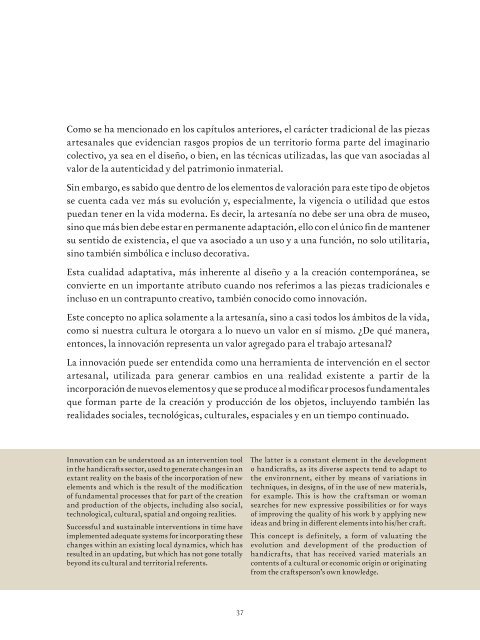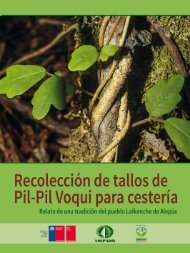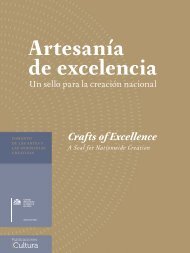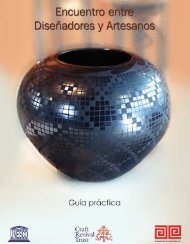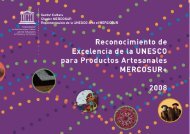artesania-excelencia
artesania-excelencia
artesania-excelencia
You also want an ePaper? Increase the reach of your titles
YUMPU automatically turns print PDFs into web optimized ePapers that Google loves.
Como se ha mencionado en los capítulos anteriores, el carácter tradicional de las piezas<br />
artesanales que evidencian rasgos propios de un territorio forma parte del imaginario<br />
colectivo, ya sea en el diseño, o bien, en las técnicas utilizadas, las que van asociadas al<br />
valor de la autenticidad y del patrimonio inmaterial.<br />
Sin embargo, es sabido que dentro de los elementos de valoración para este tipo de objetos<br />
se cuenta cada vez más su evolución y, especialmente, la vigencia o utilidad que estos<br />
puedan tener en la vida moderna. Es decir, la artesanía no debe ser una obra de museo,<br />
sino que más bien debe estar en permanente adaptación, ello con el único fin de mantener<br />
su sentido de existencia, el que va asociado a un uso y a una función, no solo utilitaria,<br />
sino también simbólica e incluso decorativa.<br />
Esta cualidad adaptativa, más inherente al diseño y a la creación contemporánea, se<br />
convierte en un importante atributo cuando nos referimos a las piezas tradicionales e<br />
incluso en un contrapunto creativo, también conocido como innovación.<br />
Este concepto no aplica solamente a la artesanía, sino a casi todos los ámbitos de la vida,<br />
como si nuestra cultura le otorgara a lo nuevo un valor en sí mismo. ¿De qué manera,<br />
entonces, la innovación representa un valor agregado para el trabajo artesanal<br />
La innovación puede ser entendida como una herramienta de intervención en el sector<br />
artesanal, utilizada para generar cambios en una realidad existente a partir de la<br />
incorporación de nuevos elementos y que se produce al modificar procesos fundamentales<br />
que forman parte de la creación y producción de los objetos, incluyendo también las<br />
realidades sociales, tecnológicas, culturales, espaciales y en un tiempo continuado.<br />
Innovation can be understood as an intervention tool<br />
in the handicrafts sector, used to generate changes in an<br />
extant reality on the basis of the incorporation of new<br />
elements and which is the result of the modification<br />
of fundamental processes that for part of the creation<br />
and production of the objects, including also social,<br />
technological, cultural, spatial and ongoing realities.<br />
Successful and sustainable interventions in time have<br />
implemented adequate systems for incorporating these<br />
changes within an existing local dynamics, which has<br />
resulted in an updating, but which has not gone totally<br />
beyond its cultural and territorial referents.<br />
The latter is a constant element in the development<br />
o handicrafts, as its diverse aspects tend to adapt to<br />
the environrnent, either by means of variations in<br />
techniques, in designs, of in the use of new materials,<br />
for example. This is how the craftsman or woman<br />
searches for new expressive possibilities or for ways<br />
of improving the quality of his work b y applying new<br />
ideas and bring in different elements into his/her craft.<br />
This concept is definitely, a form of valuating the<br />
evolution and development of the production of<br />
handicrafts, that has received varied materials an<br />
contents of a cultural or economic origin or originating<br />
from the craftsperson’s own knowledge.<br />
37


